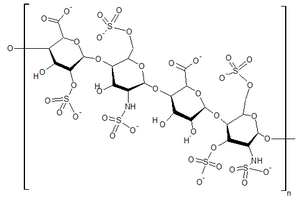Structural Biochemistry/Cell Signaling Pathways/Heparan Sulfate
Introduction
[edit | edit source]Heparan Sulfate molecules are found on the surface of the extracellular matrix of most animal tissues. It occurs as a proteoglycan (HSPG) in which two or three HS chains are attached in close proximity to cell surface or extracellular matrix proteins. A proteoglyan is a protein that is heavily glycosylated Heparan Sulfate Proteoglycans achieve are involved in development, homeostasis, and pathological processes. For example the mediation of cytokine-induced cell signaling. Their effect is achieved by interaction with different types of ligands.

Synthesis of Hepran Sulfide
[edit | edit source]The synthesis begins with the formation of a polysaccharide-protein linkage region. A four-unit sugar is attached to a serine residue at the core of the protein. The sugar is then extended by the addition of either d-acetylglucosamine or d-acetylglactosamine and d-glucuronic acid residues. This forms Heparan Sulfate structures.
Hepran Sulfate and Growth Factors
[edit | edit source]One of the most important roles of Hepran Sulfate is the meditation of growth factors and their cognate receptors. It is proposed that heparan sulfate participates in the signaling process by acting as a fine-tuner for the process, this has been prototipically demonstrated in the fibroblast GF, or FGF, family. In this family heparan sulfate acts as a necessary coreceptor.
HS and Human Disease
[edit | edit source]Somatic overgrowth can occur in patients with mutations in the HS polymerase genes. It is thought that because of the interactions with HS and growth controls, HS might act as tumor suppressor if it is functioning properly. Mutations affecting the biosynthesis of heparan sulphate proteoglycans (HSPGs) are the cause of several human hereditary diseases.
Simpson–Golabi–Behmel syndrome
[edit | edit source]It has been shown that a member of the glypican family of membrane proteoglycans, GPC3, is mutated in human patients that suffer from Simpson–Golabi–Behmel syndrome (SGBS), an X-linked disorder that is associated with developmental tissue overgrowth and with a high incidence of neuroblastomas and wilm's tumors. On the basis of an analysis of GPC3 mutations, it has been proposed that SGBS is probably caused by a lack of functional GPC3 protein, which is supported by the defects shown in GPC3-deficient mice. Although the mechanism by which changes in glypican function lead to cancer is unknown, tumour progression has been found to be associated with changes in the expression of GPC3, and increases in the expression of another member of the glypican family, GPC1, have been observed in cervical and pancreatic cancers.
Hereditary Multiple Exotoses
[edit | edit source]In this disease, benign tumors derive from the growth plates of endochondral bones. These tumors later become malignant. Interestingly, the cause is the mutations of EXT1 or EXT2 genes that encode the HS polymerase genes.
Inflamation and Tissue Repair
[edit | edit source]Major growth factors involved in skin wound repair are HB-EGF and FGF-2. This is achieved by the binding of HS to the FGF-2. When tissue is injured, neurotil heparanase is excreted the wound area to degrade the inhibition of the heparin sulfate chains. These HS chain inhibition is eliminated, HSD is liberated and stimulates FGF-2 to promote repair.
Sources
[edit | edit source]1) http://www.ncbi.nlm.nih.gov/pubmed/10872465 Functions of cell surface heparan sulfate proteoglycans. Bernfield M, Götte M, Park PW, Reizes O, Fitzgerald ML, Lincecum J, Zako M. Division of Developmental and Newborn Biology, Children's Hospital, Harvard Medical School, Boston, Massachusetts 02115, USA. bernfield@a1.tch.harvard.edu 2)